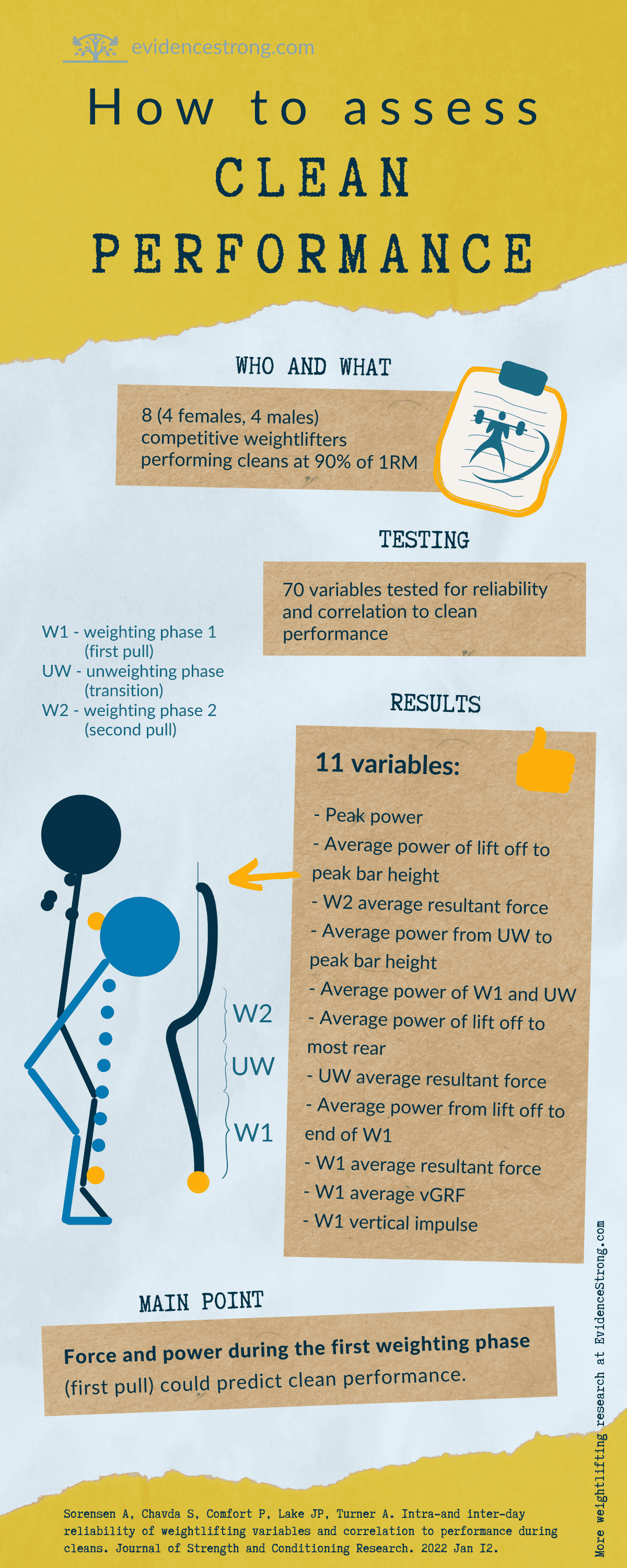Summary of an article analysing various measures and their correlation with clean performance in Olympic weightlifting.
Who
8 (4 females, 4 males) competitive (at the regional and national level) Olympic weightlifters (UK).
Design
Repeated measures experimental study:
- 3 testing sessions
- 3 sets of 1 clean at 90% of 1RM
- 1-minute rest between sets
Outcome measures/tests
- inter- and intra-day reliability
- 70 variables
- measured during 3 phases of clean lift:
- W1 - weighting 1 (first pull)
- UW - unweighting (transition)
- W2 - weighting 2 (second pull)
Main results
11 variables had good to excellent reliability (out of 70 analysed) and a strong correlation with a clean performance at 90% of 1RM. Seven of the variables included the W1 phase of the lift.
2 groups of variables:
- temporal force (5 variables)
- W1 average resultant force - the best reliability and almost perfect correlation to clean performance
- bar power (6 variables)
- average bar power of W1+UW - the highest intra-day reliability
- bar peak power and average power of UW to peak bar hight (PBH) - the highest inter-day reliability
- temporal force (5 variables)
performance of W1 determines clean performance at 90% of 1RM (7 variables)
Weightlifting variables:
VariablesTemporal forceW1 vertical impulseW1 average vGRFW1 average resultant forceUW average resultant forceW2 average resultant forceBar powerPeak powerAverage power from lift off to W1 endAverage power of W1 and UWAverage power of lift off to most rearAverage power of lift off to PBHAverage power of UW to PBHReliabilityVariablesTemporal forceW1 vertical impulseexcellentW1 average vGRFexcellentW1 average resultant forceexcellentUW average resultant forceexcellentW2 average resultant forceexcellentBar powerPeak powerexcellentAverage power from lift off to W1 endexcellentAverage power of W1 and UWexcellentAverage power of lift off to most rearexcellentAverage power of lift off to PBHexcellentAverage power of UW to PBHexcellentCorrelation to clean performanceVariablesTemporal forceW1 vertical impulsevery strongW1 average vGRFstrongW1 average resultant forcenear perfectUW average resultant forcevery strongW2 average resultant forcevery strongBar powerPeak powervery strongAverage power from lift off to W1 endvery strongAverage power of W1 and UWvery strongAverage power of lift off to most rearvery strongAverage power of lift off to PBHnear perfectAverage power of UW to PBHnear perfect
Take home message
Interview with the author of the original article
Angela Sorensen is a weightlifting coach, athlete and educator. She is a PhD student at Middlesex University, UK where she is examining phases of the clean and how training interventions can influence the clean performance.
Original article
Sorensen A, Chavda S, Comfort P, Lake JP, Turner A. Intra-and inter-day reliability of weightlifting variables and correlation to performance during cleans. Journal of Strength and Conditioning Research. 2022 Jan 12.
